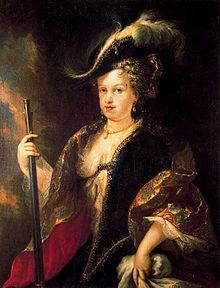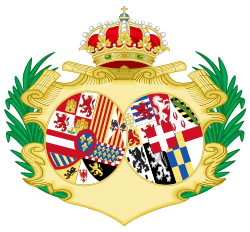- Maria Luisa of Savoy
-
Maria Luisa of Savoy 
Queen consort of Spain Tenure 2 November 1701 – 14 February 1714 Spouse Philip V Issue Louis I of Spain
Ferdinand VI of SpainFull name Maria Luisa Gabriella di Savoia House House of Bourbon
House of SavoyFather Victor Amadeus II, Duke of Savoy Mother Anne Marie d'Orléans Born 17 August 1688
Royal Palace of Turin, SavoyDied 14 February 1714 (aged 25)
Royal Alcazar of Madrid, SpainBurial El Escorial Religion Roman Catholicism Not to be confused with Princess Marie Louise of Savoy.Maria Luisa of Savoy (Maria Luisa Gabriella; 17 September 1688 – 14 February 1714) was a Savoyard princess and the first wife of Philip V of Spain.[1] She acted as Regent of Spain and had great influence over her husband. She is closely associated with Princesse des Ursins.
Contents
Infancy and background
She was the third daughter and second surviving child of Victor Amadeus II, Duke of Savoy and his French-born wife Anne Marie d'Orléans, the youngest daughter of Philippe of France and Henrietta of England. Throughout her life, Maria Luisa remained close to her older sister Maria Adelaide who later married Louis, Duke of Burgundy, the eldest grandson of Louis XIV. In her youth, Maria Luisa was described as playful and fun loving and had received a good education.[2]
Marriage
Philip V of Spain, a French prince, was recently crowned King of Spain upon the death of childless Charles II. In order to enforce his shaky authority over Spain due to his French birth, Philip V decided to maintain ties with Victor Amadeus II, Duke of Savoy. Philip V's brother, Louis, Duke of Burgundy, had married the elder sister of Maria Luisa several years earlier, and in mid 1701, Philip V asked for Maria Luisa's hand with the permission of his grandfather Louis XIV.[3]
Maria Luisa was wed by proxy to Philip V on 12 September 1701 at the age of barely thirteen and was escorted to Nice, arriving there on 18 September. While in Nice, she was greeted by Pope Clement XI who gave her the Golden Rose on 20 September as a ritualistic gift for the young princess.[2] Within a week, she sailed from Nice for Antibes and was taken to Barcelona. The official marriage took place on 2 November 1701.[2] The princesse des Ursins was a member of the household of the Queen. She would maintain great influence over Maria Luisa as her Camarera mayor de Palacio, chief of the household to the young queen, who was still a child.
The couple were deeply in love.[citation needed] In 1702, Philip V was obliged to leave Spain to fight in Naples as part of the ongoing War of Spanish Succession.[4] During her husband's absence, Maria Luisa acted as Regent from Madrid. She was praised as an effective ruler, having successfully implemented various changes in government and insisted upon all complaints being investigated and reports made direct to her. Her leadership encouraged the reorganization in the junta and, in doing this, inspiring people and their cities to make donations towards the war effort.[1] Despite her young age, Maria Luisa's effective regency made her admired in Madrid and throughout Spain. After her husband's return in 1703, she resumed her role as queen consort. In 1704, the Princesse des Ursins was exiled at the order of Louis XIV, devastating Maria Luisa. However, in 1705, the Princesse des Ursins returned to Madrid, much to the joy of the young queen.[5]
Maria Luisa gave birth to the couple's first child, Infante Luis Felipe in 1707. After the birth of her eldest child, Maria Luisa went on giving birth to three more children, two of whom would survive infancy. Towards the end of her life, the Queen became ill with tuberculosis. She eventually died from the effects of tuberculosis on 14 February 1714. She was buried at San Lorenzo de El Escorial. Maria Luisa died in her 25th year.
In December 1714, just months after Maria Luisa's death, her widower Philip V remarried, to Elisabeth Farnese, the only child and heiress of Duke of Parma. All of Maria Luisa's children were to die without issue, leaving behind no descendants of Maria Luisa of Savoy.
Legacy
She was nicknamed La Savoyana by her adoring subjects and was well loved in Spain. After her death, two of her sons, her youngest and oldest, were to become Kings of Spain. Her niece, Princess Maria Luisa was named after her.
Issue
- Louis I of Spain (25 August 1707 – 31 August 1724) married Louise Élisabeth d'Orléans, no issue.
- Infante Felipe of Spain (2 July 1709 – 18 July 1709)
- Infant Felipe Pedro Gabriel of Spain (7 June 1712 – 29 December 1719) died in childhood.
- Ferdinand VI of Spain (23 September 1713 – 10 August 1759) married Infanta Maria Barbara of Portugal, no issue.
Ancestry
Titles, styles, honours and arms
Titles and styles
- 17 September 1688 – 2 November 1701 Her Highness Princess Maria Luisa of Savoy
- 2 November 1701 – 14 February 1714 Her Majesty the Queen of Spain
Arms
References
- ^ a b Sharp. Martin Andrew: Queens of old Spain, New York, McClure, Phillips & company, 1906, p 532
- ^ a b c The Gentleman's magazine, Volumes 302-303, F. Jefferies, 1789, p 284
- ^ The Gentleman's magazine, Volumes 302-303, F. Jefferies, 1789, p 286
- ^ Sharp. Martin Andrew: Queens of old Spain, New York, McClure, Phillips & company, 1906, p 531
- ^ Sharp. Martin Andrew: Queens of old Spain, New York, McClure, Phillips & company, 1906, p 535
External links
 Media related to Maria Luisa of Savoy at Wikimedia Commons
Media related to Maria Luisa of Savoy at Wikimedia CommonsSee also
Maria Luisa of SavoyBorn: 17 November 1688 Died: 14 February 1714Spanish royalty Preceded by
Mariana of NeuburgQueen consort of Spain
2 November 1701 – 14 February 1714Succeeded by
Elisabeth FarneseQueen consort of Naples and Sardinia
Duchess consort of Brabant, Guelders, Limburg, Lothier, Luxembourg and Milan
Countess consort of Flanders, Hainaut and Namur
1700–1713Succeeded by
Elisabeth Christine of Brunswick-WolfenbüttelQueen consort of Sicily
1700–1713Succeeded by
Anne Marie d'OrléansPrincesses of Savoy 1st generation none2nd generation 3rd generation Princess Maria · Margherita, Countess of Saint-Pol · Charlotte, Queen of France · Agnes, Countess of Dunois · Maria, Countess of Saint-Pol · Bona, Duchess of Milan · Princess Anna4th generation Louise, Duchess of Nemours · Philiberta, Duchess of Nemours · Antonia, Lady of Monaco · Claudina, Countess of Hornes · Princess Philippina · Princess Margherita · Princess Giovanna5th generation Yolande, Duchess of Savoy · Princess Catherine · Princess Maria · Princess Isabella6th generation none7th generation Margherita, Vicereine of Portugal · Isabella, Hereditary Princess of Modena · Princess Maria Apollonia · Princess Francesca Catherina · Princess Giovanna8th generation Luisa Cristina, Princess Maurice of Savoy · Margherita Violante, Duchess of Parma · Henriette Adelaide, Electress of Bavaria · Princess Catherine Beatrice · Princess Christine Charlotte · Louise, Hereditary Princess of Baden-Baden · Marie Jeanne, Duchess of Savoy · Marie Françoise, Queen of Portugal9th generation Maria Vittoria, Countess of Cercenasco* · Isabella Luisa, Countess of Lagnasco*10th generation Maria Adelaide, Dauphine of France · Princess Maria Anna · Maria Luisa, Queen of Spain · Anne Thérèse, Princess of Soubise · Marie Jeanne, Mademoiselle de Soissons · Louise Philiberte, Mademoiselle de Carignan · Françoise, Mademoiselle de Dreux11th generation Princess Eleonora · Princess Maria Luisa · Princess Maria Felicita · Princess Vittoria Margharita · Princess Charlotte · Leopoldina, Princess of Melfi · Princess Polyxena · Gabrielle, Princess of Lobkowicz · Maria Luisa, Princess of Lamballe* · Caterina, Princess of Paliano · Maria Anna Victoria, Duchess in Saxony12th generation Princess Maria Elisabetta · Marie Joséphine, Countess of Provence · Maria Teresa, Countess of Artois · Maria Anna, Duchess of Chablais · Princess Maria Cristina Giuseppina · Maria Carolina, Electoral Princess of Saxony13th generation 14th generation Princess Maria Cristina15th generation 16th generation 17th generation Yolande, Countess of Bergolo · Mafalda, Landgravine of Hesse · Giovanna, Tsaritsa of Bulgaria · Maria Francesca, Princess Luis of Parma · Bona Margherita, Princess Konrad of Bavaria* · Princess Adelaide*18th generation Maria Pia, Princess Michael of Parma · Maria Gabriella, Mrs Zellinger de Balkany · Maria Beatrice, Mrs Reyna-Corvalán y Dillon · Margherita, Archduchess of Austria-Este** · Maria Cristina, Princess Casimir of the Two Sicilies** · Princess Isabella*19th generation Bianca, Countess Arrivabene-Valenti-Gonzaga** · Mafalda, Baroness Lombardo di San Chirico**20th generation *Princess of Savoy-Genoa
**Princess of Savoy-AostaSpanish royal consorts Princess Sophía of Greece and Denmark (1975–)
Princess Victoria Eugenie of Battenberg (1906–1931) · Archduchess Maria Christina of Austria (1879–1885) · Princess Mercedes of Orléans (1878) · Maria Vittoria dal Pozzo (1870–1873) · Infante Francis of Spain, Duke of Cádiz (1846–1868) · Princess Maria Christina of the Two Sicilies (1829–1833) · Princess Maria Josepha of Saxony (1819–1829) · Infanta Maria Isabel of Portugal (1816–1818) · Julie Clary (1808–1813) · Princess Maria Luisa of Parma (1788–1808) · Princess Maria Amalia of Saxony (1759–1760) · Infanta Barbara of Portugal (1746–1758) · Elisabeth Farnese (1724–1746) · Louise Élisabeth d'Orléans (1724) · Elisabeth Farnese (1714–1724) · Princess Maria Luisa of Savoy (1701–1714) · Countess Palatine Mariana of Neuburg (1690–1700) · Marie Louise d'Orléans (1679–1689) · Archduchess Mariana of Austria (1649–1665) · Princess Élisabeth of France (1621–1644) · Archduchess Margaret of Austria (1598–1611) · Archduchess Anna of Austria (1570–1580) · Princess Élisabeth of France (1559–1568) · Queen Mary I of England (1556–1558) · Infanta Isabella of Portugal (1526–1539)Categories:- Royal consorts of Naples
- Royal consorts of Sicily
- Deaths from tuberculosis
- Spanish royal consorts
- Duchesses of Brabant
- Duchesses of Limburg
- Duchesses of Luxembourg
- Countesses of Flanders
- Countesses of Hainaut
- Duchesses of Milan
- Regents of Spain
- 17th-century Italian people
- 18th-century Italian people
- House of Savoy
- 1688 births
- 1714 deaths
- People from Turin (city)
- Princesses of Savoy
- Recipients of the Golden Rose
- Burials in the Pantheon of Kings at El Escorial
- Female regents
- Regents
Wikimedia Foundation. 2010.

